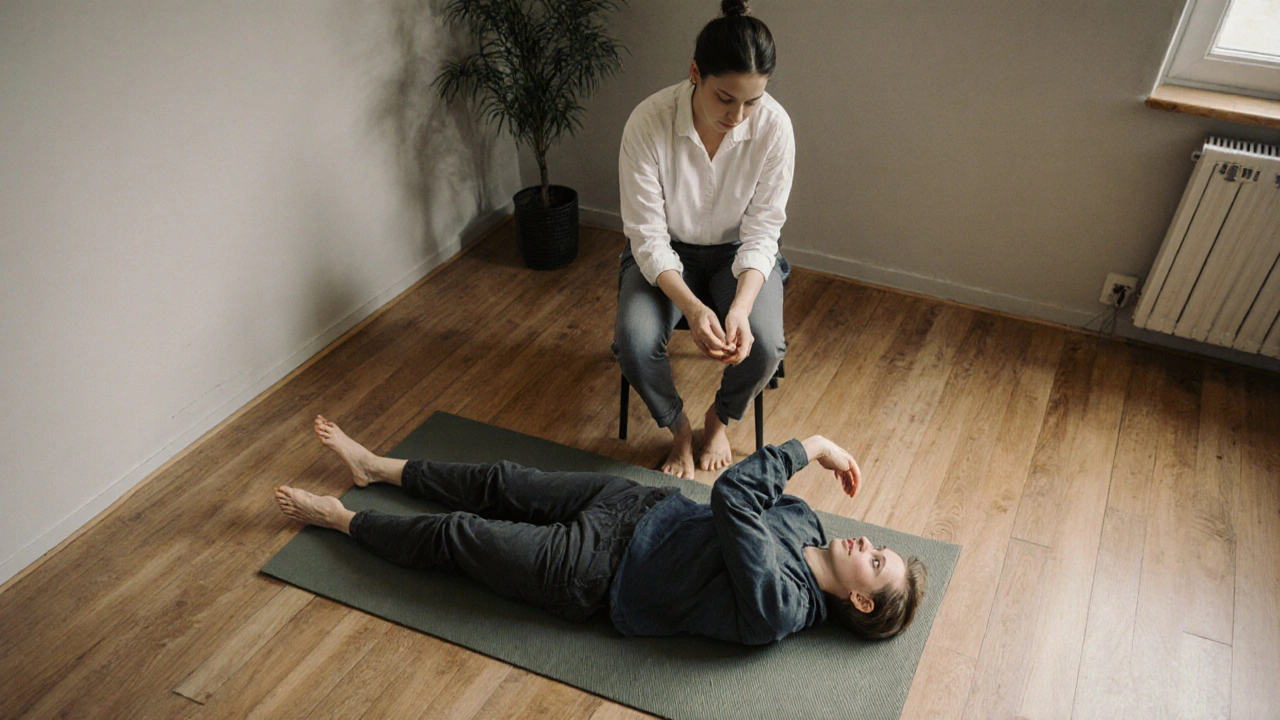Posture Movement Calculator
How to Use This Tool
Enter your daily tension points and movement frequency to see how small mindful movements can reduce tension over time. Based on principles from Feldenkrais training.
Your Tension Points
Your Posture Potential
Your Daily Movement Score
Based on your tension points and movement frequency
72
Low
High
What Your Score Means
This score shows your potential for reducing unnecessary tension through mindful movement. A score of 70+ means your nervous system is already beginning to find ease in movement—just like the article describes.
What to try: Pause every 20 minutes at your desk. Ask yourself: "How am I holding myself right now?" Notice if your shoulders are tight, jaw clenched, or gripping chair arms. Just noticing is enough to begin change—no forced movement needed.
Most people think bad posture is just about slouching or hunching over a phone. But if you’ve tried squeezing your shoulders back, doing endless core exercises, or buying that expensive ergonomic chair-yet still feel stiff, tired, or achy-you’re not broken. You’re just moving wrong. Feldenkrais training doesn’t tell you to ‘stand up straight.’ It teaches your nervous system how to find ease in movement, and that’s where real posture change happens.
What Feldenkrais Training Actually Is
Feldenkrais training isn’t stretching, yoga, or physical therapy. It’s a method of movement reeducation developed by Moshe Feldenkrais, a physicist and judo master, in the 1940s. He noticed that people didn’t need more strength to fix posture-they needed better awareness. His method uses gentle, slow movements to help your brain reconnect with parts of your body you’ve forgotten how to use.
Unlike traditional exercise, Feldenkrais doesn’t aim to strengthen muscles. It aims to rewire your brain’s map of your body. Think of it like updating an outdated GPS. Your brain still thinks your shoulders are hunched forward because that’s the pattern it learned over years of sitting, scrolling, or carrying heavy bags. Feldenkrais gives your brain new data: Wait, I can let my shoulders rest here, and it’s still stable.
Why Your Posture Doesn’t Improve With Exercises
Crunches, planks, and wall angels might feel like they’re fixing your posture, but they often just add more tension. You’re forcing a position instead of learning a new way to move. That’s why people who do yoga for years still end up with rounded shoulders or a forward head.
Here’s the truth: posture isn’t a static shape. It’s a dynamic balance. When you sit, stand, or walk, your body should be able to shift, adjust, and recover without effort. Most people lock themselves into one ‘good’ position-and that’s actually the problem. Your spine isn’t meant to be rigid. It’s meant to move fluidly.
Feldenkrais works because it doesn’t fight your habits. It gently shows you alternatives. You learn to notice when you’re gripping your jaw while typing, or when your hips are stuck in one position while walking. That awareness is the first step to change.
How Feldenkrais Changes Your Body’s Movement Patterns
During a Feldenkrais session-whether in a group class or private lesson-you lie on a mat or sit in a chair while the teacher guides you through tiny, slow movements. One lesson might involve slowly rolling your head side to side while keeping your shoulders relaxed. Another might have you imagine your pelvis sliding forward and back like a bowl of water.
These movements seem too small to matter. But here’s what happens: your brain pays attention. For the first time in years, you feel the difference between moving with tension and moving with ease. You start to notice how your ribs move when you breathe, or how your feet connect to the floor when you stand.
After just a few sessions, people report things like:
- Standing taller without forcing it
- Walking without pain in the lower back
- Neck stiffness disappearing after hours at a desk
- Not needing to ‘adjust’ their posture every five minutes
These aren’t magic fixes. They’re the result of your nervous system learning new, more efficient ways to organize itself.
Real-Life Examples: From Desk Jockeys to Athletes
One client I worked with in Perth, a 42-year-old software developer, came in with chronic upper back pain. He’d tried physio, chiropractic care, and even acupuncture. Nothing stuck. In his first Feldenkrais class, he did a simple exercise: slowly turning his head while keeping his shoulders still. He was surprised to realize he couldn’t turn his head without lifting his shoulder. That’s when he understood his neck and shoulder muscles had been stuck in a fight-or-flight pattern for years.
After six weeks of weekly sessions, he stopped needing painkillers. He didn’t do a single core exercise. He just moved differently.
Another example: a 68-year-old dancer who’d lost flexibility after hip surgery. Traditional rehab had her doing leg lifts and stretches. She felt worse. In Feldenkrais, she learned to move from her pelvis in tiny, exploratory ways. Within a month, she could walk without a cane and even danced again at her granddaughter’s wedding.
Feldenkrais doesn’t care if you’re young or old, injured or athletic. It works on the level of your nervous system-where all movement begins.

What You’ll Learn in a Typical Feldenkrais Class
A typical group class, called an Awareness Through Movement lesson, lasts 45 to 60 minutes. You don’t need any experience. You wear loose clothes and lie on a mat. The teacher speaks slowly, guiding you through a sequence of movements.
Here’s what you’ll actually experience:
- You’ll be asked to notice how your body feels before the movement-even if it’s just a slight heaviness in your left hip.
- You’ll do a movement so small you might wonder if it’s working. Maybe you just tilt your pelvis a quarter inch.
- You’ll repeat it slowly, then try it differently. What happens if you breathe in while moving? What if you imagine your spine is made of jelly?
- You’ll pause and notice the difference. Is your breathing easier? Does your neck feel lighter?
- You’ll end by lying still, letting your body integrate the new information.
There’s no right or wrong way to do it. If you feel awkward, confused, or bored-that’s normal. Your brain is learning something new. The magic happens in the quiet moments after the movement, when your body quietly reorganizes itself.
How Often Should You Practice?
You don’t need to do Feldenkrais every day. In fact, doing it too often can overwhelm your nervous system. One class a week is enough to start seeing changes. Many people notice improvements after just three sessions.
Between classes, you don’t need to practice exercises. Instead, try this: once a day, pause for 30 seconds and ask yourself: How am I holding myself right now? Are your shoulders tight? Is your jaw clenched? Are you gripping the arms of your chair? Just noticing is enough. That’s the beginning of change.
Some people start with private lessons if they have chronic pain or injury. Others begin with group classes and find they love the quiet, meditative feel of it. Both work.
What Feldenkrais Isn’t
It’s not a quick fix. Don’t expect to walk out of your first class standing like a model. Real change takes time because it’s happening in your brain, not just your muscles.
It’s not a massage. You won’t be touched unless you’re in a private lesson and you’ve agreed to it.
It’s not spiritual or mystical. No chanting, no crystals, no energy fields. It’s science-based. Neuroplasticity-the brain’s ability to rewire itself-is the foundation.
And it’s not a replacement for medical care. If you have a herniated disc, nerve damage, or a recent fracture, talk to your doctor first. But if you’re dealing with chronic stiffness, tension, or just feeling ‘off’ in your body, Feldenkrais can help you move beyond the pain.

Where to Find Feldenkrais Training
Feldenkrais practitioners are certified through accredited programs that require 800+ hours of training. Look for someone with credentials from the Feldenkrais Guild of North America, the Feldenkrais Association of Australia, or the European Feldenkrais Federation.
In Australia, many practitioners offer classes in community centers, yoga studios, or private clinics. Online classes are also widely available. Start with a free introductory lesson-many teachers offer them. Watch how the teacher speaks. Do they sound calm? Do they encourage curiosity, not perfection? That’s the sign of a good practitioner.
Why This Works When Nothing Else Did
You’ve probably tried everything: stretches, posture correctors, gym workouts, even posture apps that buzz when you slouch. But none of those taught your brain to move differently. They just reminded you to do something you already knew how to do-only worse.
Feldenkrais works because it doesn’t demand effort. It invites exploration. It doesn’t tell you what’s wrong with you. It shows you what you haven’t noticed yet.
When your brain learns that you can sit without gripping your lower back, or walk without dragging your feet, your posture changes naturally. You don’t have to think about it. You just do it-because your body now knows a better way.
Final Thought: Posture Is Not a Pose
Good posture isn’t about looking perfect. It’s about moving with ease, breathing without restriction, and feeling at home in your own body. Feldenkrais training doesn’t fix your posture. It gives you back the freedom to move-without pain, without forcing, without exhaustion.
That’s not just better posture. That’s a better life.
Can Feldenkrais training help with chronic back pain?
Yes. Many people with chronic back pain find relief through Feldenkrais because it addresses the root cause: inefficient movement patterns. Instead of strengthening muscles, it teaches the nervous system to release unnecessary tension. Studies published in the Journal of Bodywork and Movement Therapies show significant reductions in pain intensity after 8-12 sessions, especially for non-specific lower back pain.
Do I need special equipment or clothing?
No. You only need loose, comfortable clothing and a mat or cushion to lie on. No shoes, no props, no gear. Most classes are done on the floor, but seated options are available if you have mobility issues. The focus is on internal awareness, not external tools.
Is Feldenkrais the same as yoga or Pilates?
No. Yoga and Pilates focus on holding poses and building strength. Feldenkrais focuses on exploring movement with awareness. There’s no goal to achieve a perfect form. You’re not trying to stretch further or hold longer-you’re trying to feel the difference between effort and ease. Many people do Feldenkrais alongside yoga or Pilates and find it deepens their practice.
How long does it take to see results?
Some people notice subtle changes after one session-like breathing more deeply or feeling less tension in their neck. For lasting posture improvement, most people see clear results after 6-10 sessions. The changes are cumulative. Your brain keeps integrating the new patterns even after the class ends.
Can children or older adults do Feldenkrais?
Absolutely. Feldenkrais is one of the few movement methods safe for all ages. Children with developmental delays, older adults recovering from falls, and even people with Parkinson’s have benefited. Lessons are adapted to your ability. You move at your own pace, with no pressure to perform.

